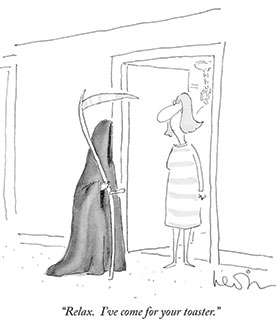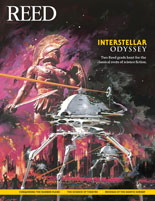
IRIS login | Reed College home Volume 94, No. 1: March 2015
Reediana
I Only Read It for the Cartoons:
The New Yorker's Most Brilliantly Twisted Artists
(New Harvest, 2014)
Richard Gehr ’78

It’s a common experience in certain households: grabbing the new issue of the New Yorker, skipping right past the articles, and going straight for the real goods: the cartoons. Usually a single panel, with or without a caption, each one a world unto itself, the famous cartoons are variously whimsical, beautiful, and tragic—and often hilarious.
Richard Gehr ’78 was raised on New Yorker cartoons. But recently, he became interested in going deeper: what about the people who create these little worlds? His entertaining and illuminating new book, I Only Read It for the Cartoons: The New Yorker’s Most Brilliantly Twisted Artists, is the fruit of his quest for the answer to this question.
For anyone who wants to know the nuts and bolts of the cartoon-publishing process, there is information—like the fact that only 0.075% of all submitted cartoons end up making the cut—but the real soul of the book is its insight into the creative process of the artists. We finally see them as individual selves creating out of love, and ultimately gain an unrivaled perspective on what distinguishes New Yorker cartoons as an art form all their own.
A Portland native, Richard went to Lincoln High School with Matt Groening, a lifelong friend who would go on to create The Simpsons and who wrote the foreword to the book. He had an early interest in philosophy and critical theory—a “teenage structuralist,” he calls himself—but his first Reed experience actually took place before he was a student, when he skipped a day of high school to hang out on campus with the Merry Pranksters. Transferring to Reed from Portland State, he majored in philosophy, although he preferred the continental tradition to the analytic one emphasized at Reed, and the two professors who influenced him the most both taught French: Prof. Jane McLelland [French 1974–81], whom he remembers as “whip smart and all about clarity of thinking,” and Prof. Sam Danon [French 1962–2000], who “portrayed a French intellectual wonderfully and made you want to be one when you grew up.”
After a stint in grad school, Richard pursued a career in journalism, writing everything from book reviews to a biography of the band Phish. “My career is a perfect example of what a liberal arts education can provide,” he reflects. “My whole life is about making it up.”
This combination of curiosity and improvisation led to this book. When veteran New Yorker cartoonist Leo McCullum died in 2010, Richard googled his name in search of interviews, but found nothing. “This is wrong,” he thought. “This is an important American art form and someone should be documenting it.”

For example, there’s Roz Chast, whose cartoons feature eccentric characters who seem to exist in private neurotic worlds of their own devising, and jokes that don’t necessarily adhere to the logic of ordinary humor. Her first published New Yorker cartoon, labeled “Little Things,” depicted imaginary small objects like the “chent” and the “spak” that are reminiscent of the various bits of hardware that might be found at the back of some household drawer, but for the fact that they have no discernible purpose. They’re just odd little shapes, and that’s the entire joke. And Chast herself? She turns out to be an insomniac with a severe phobia of latex balloons (Mylar ones are fine) and hobbies including weaving hook rugs and pysanky, a painstaking Ukrainian style of decorating Easter eggs.So he made up a way to do it. He began writing a series of Q&As with New Yorker cartoonists for a publication called The Comics Journal, which would eventually form the basis for this book. The cartoonists were universally welcoming and open, he says, almost all of them inviting him into their homes, and this intimacy provided him with the insight that makes up the central organizing principle of his book. “It’s not like the work’s drawn from their lives,” he explains, “it’s more like their work and their lives are so intermeshed that there’s no boundary.”
Or there’s George Booth, whose characters live among the “detritus of life,” old pieces of broken machinery and tools scattered across their homes and lawns. There is no clear explanation for this fact in the cartoons and it is often irrelevant to the gag, although it does contribute greatly to the cartoons’ atmosphere, their sense of zaniness. But the reason why Booth draws this way turns out to be simply that this is exactly how he lives himself—surrounded by clutter.
Richard sometimes draws on his philosophical background, at times touching (gently) on theories of humor from such thinkers as Nietzsche and Kant in order to crystallize a point. But the main focus is on the form of New Yorker cartoons themselves, which have developed into a genre all their own. He traces the internal logic of each cartoonist’s individual sensibility as well as the hidden dynamics behind the classic tropes like the castaway on a desert island or the patient on a psychoanalyst’s couch. His favorite trope is the Grim Reaper, because death is “the big punchline.” In one of his favorite examples, a panel by Arnie Levin, Death shows up at a woman’s door only to tell her, “Relax. I’ve come for your toaster.”
Richard is a gifted writer, capable of such descriptions as: “[Victoria Roberts’] cartoons are theatrical vignettes, extremely short plays for precisely two people, a G-rated Who’s Afraid of Virginia Woolf? condensed to its essence.”
But he prefers to let his subjects do the talking, and if he is a skilled writer he is at least as good an interviewer, snagging quotes like this one from Levin describing how he draws noses: “It’s like a key signature in music. For instance, if I wanted to do something outrageous or stupid—Lee used to say, ‘Make it more dumb’—I would make a stupid nose in the key signature of dumb. But if I want to make a point in a political gag, I draw something with a little more resonance or focus.”
You can’t make stuff like that up; it could only have come from the mouth of a real New Yorker cartoonist. The book is full of such nuggets, and ultimately they are what make it memorable, each one as mordant and as sublime as a classic Grim Reaper gag.

LATEST COMMENTS
steve-jobs-1976 I knew Steve Jobs when he was on the second floor of Quincy. (Fall...
Utnapishtim - 2 weeks ago
Prof. Mason Drukman [political science 1964–70] This is gold, pure gold. God bless, Prof. Drukman.
puredog - 1 month ago
virginia-davis-1965 Such a good friend & compatriot in the day of Satyricon...
czarchasm - 4 months ago
John Peara Baba 1990 John died of a broken heart from losing his mom and then his...
kodachrome - 7 months ago
Carol Sawyer 1962 Who wrote this obit? I'm writing something about Carol Sawyer...
MsLaurie Pepper - 8 months ago
William W. Wissman MAT 1969 ...and THREE sisters. Sabra, the oldest, Mary, the middle, and...
riclf - 10 months ago